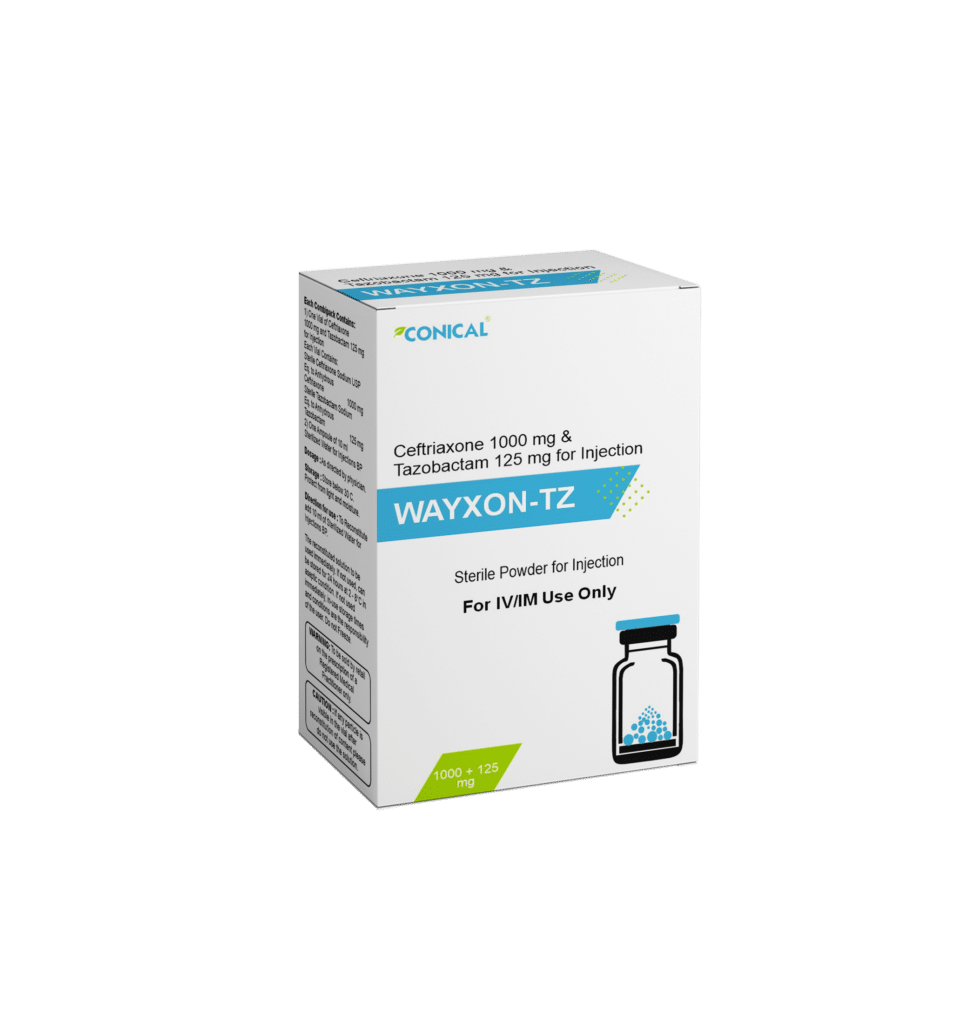
Ceftriaxone & Tazobactam for Injection is indicated in the following conditions:
– Lower respiratory tract infections and community-acquired pneumonia
– Acute bacterial otitis media
– Skin and skin structure infections
– Urinary tract infections
– Uncomplicated gonorrhea
– Pelvic inflammatory disease
– Bacterial septicemia
– Bone and joint infections
– Intra-abdominal infections
– Bacterial meningitis
– Peri-operative prophylaxis of infections associated with surgery
Adults: The usual adult dose is 1000/125 mg of ceftriaxone/tazobactam given once a day (or in equally divided doses twice a day) depending upon the severity of the infection. The total daily dose should not exceed 4 gm (in terms of ceftriaxone).
For pre-operative use (surgical prophylaxis), a single I.V. dose of 1 gm administered half an hour to 2 hours before surgery is recommended. Generally, ceftriaxone/tazobactam should be continued for at least 2 days after the signs and symptoms of infection have disappeared. The usual duration of therapy is 4–14 days; in complicated infections, longer therapy may be required. When treating Streptococci pyogenes, the therapy should be continued for at least 10 days.
Ceftriaxone may be administered by deep intramuscular injection, or as a slow intravenous injection/ infusion, after reconstitution of the solution according to the directions given below.
Pediatric Patients: For the treatment of serious infections, the recommended dose is 50–75 mg/kg (in terms of ceftriaxone) given in divided doses every 12 hours. The total daily dose should not exceed 2 gm (in terms of ceftriaxone). For the treatment of acute bacterial otitis media, a single intramuscular dose of 50 mg/kg (not to exceed 1 gram) is recommended.
Local reactions-pain, induration and tenderness was 1% overall. Phlebitis was reported in <1% after IV administration.
Hypersensitivity-rash (1.7%). Less frequently reported (<1%) were pruritus, fever or chills.
Hematologic-eosinophilia (6%), thrombocytosis (5.1%) and leukopenia (2.1%). Less frequently reported (<1%) were anemia, hemolytic anemia, neutropenia, lymphopenia, thrombocytopenia and prolongation of the prothrombin time.
Gastrointestinal-diarrhea (2.7%). Less frequently reported (<1%) were nausea or vomiting, and dysgeusia.
Hepatic-elevations of SGOT (3.1%) or SGPT (3.3%). Less frequently reported (<1%) were elevations of alkaline phosphatase and bilirubin.
Renal-elevations of the BUN (1.2%). Less frequently reported (<1%) were elevations of creatinine and the presence of casts in the urine.
Central nervous system-headache or dizziness were reported occasionally (<1%).
Genitourinary-moniliasis or vaginitis were reported occasionally (<1%).
Miscellaneous-diaphoresis and flushing were reported occasionally (<1%).
Other rarely observed adverse reactions (<0.1%) include abdominal pain, agranulocytosis, allergic pneumonitis, anaphylaxis, basophilia, biliary lithiasis, bronchospasm, colitis, dyspepsia, epistaxis, flatulence, gallbladder sludge, glycosuria, hematuria, jaundice, leukocytosis, lymphocytosis, monocytosis, nephrolithiasis, palpitations, a decrease in the prothrombin time, renal precipitations, seizures, and serum sickness.
Gastrointestinal-stomatitis and glossitis.
Genitourinary-oliguria.
Dermatologic-exanthema, allergic dermatitis, urticaria, edema. As with many medications, isolated cases of severe cutaneous adverse reactions (erythema multiforme, Stevens-Johnson syndrome or Lyell’s syndrome/toxic epidermal necrolysis) have been reported.
This product should be given cautiously to penicillin-sensitive patients. Serious acute hypersensitivity reactions may require the use of subcutaneous epinephrine and other emergency measures.
Clostridium difficile associated diarrhea has been reported with nearly all antibacterial agents, including ceftriaxone/tazobactam, and may range in severity from mild to life-threatening. Therefore, it is important to consider this diagnosis in patients who present with diarrhea subsequent to the administration of antibacterial agents.
An immune mediated hemolytic anemia has been observed in patients receiving cephalosporin class anti-bacterial including Ceftriaxone. If a patient develops anemia while on ceftriaxone, the diagnosis of a cephalosporin associated anemia should be considered and ceftriaxone stopped until the etiology is determined. Although transient elevations of BUN and serum creatinine have been observed, at the recommended dosages, the nephrotoxic potential of ceftriaxone/ tazobactam is similar to that of other cephalosporins.
Alterations in prothrombin times have occurred infrequently in patients treated with ceftriaxone/ tazobactam. Patients with impaired vitamin K synthesis or low vitamin K stores (e.g., chronic hepatic disease and malnutrition) may require monitoring of prothrombin time during Ceftriaxone and tazobactam treatment.
It should also be prescribed with caution in individuals with a history of gastrointestinal disease, especially colitis. There have been reports of sonographic abnormalities in the gall bladder of patients treated with ceftriaxone/ tazobactam; some of these patients also had symptoms of gall bladder disease.
Cases of pancreatitis, possibly secondary to biliary obstruction, have been reported rarely in patients treated with ceftriaxone/tazobactam.
Ceftriaxone is excreted via both biliary and renal excretion. Therefore, patients with renal failure normally require no dosage adjustment when the usual doses of ceftriaxone/tazobactam are administered, but concentrations of the drug in the serum should be monitored periodically. If evidence of accumulation exists, the dosage should be decreased accordingly.
Store below 30oC. Protect from light and moisture.
Keep out of reach of children.
10 ml glass vial with bromobutyl rubber stopper, sealed with a flip-off aluminium seal.
Ceftriaxone 1000 mg & Tazobactam 125 mg dry powder for injection in glass vial is supplied with 10 ml plastic ampoule of diluent Sterilized Water for Injections BP in unit carton with pack insert.
Contact us directly to receive full information on the product, the formulation, the science behind it, stability data, and more. Our Business Development Manager is a click away.
Conical Pharmaceuticals is a professionally managed and dynamic organization with decades of experience in the pharmaceutical field. With a desire of providing opportunities for a better life, we work very hard to bring quality drugs to our customers. We have instilled a level of trust and confidence amongst our clients by supplying the best quality products.